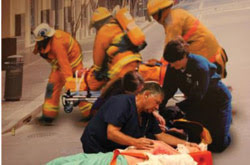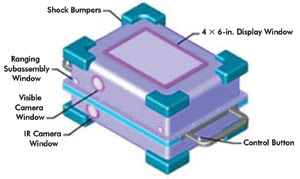
Vital signs at a distance and in a hurry
By combining camera video technology with standoff laser vibration measurement techniques, researchers hope to help first responders save lives. The chances of success, though, depend on being able to cram components into a small space without the resulting unit being too costly.
The US Department of Homeland Security’s Science & Technology (S&T) Directorate is spearheading the development of a standoff patient triage tool. The goal is to produce a unit the size of a legal notebook that can take vital signs at 20 paces in 30 s. By comparison, gathering temperature, pulse, respiration and other vital medical data today takes as long as 5 min and can only be done up close.
 S&T Tech Solutions director Greg Price noted that the tool is likely to make use of some familiar technology. “We’re incorporating the same technology used in handheld video cameras for image stabilization. Early testing shows much promise in the ability to stabilize the primary focal point for collecting vital sign readings from a distance of 5 to 40 ft.”
S&T Tech Solutions director Greg Price noted that the tool is likely to make use of some familiar technology. “We’re incorporating the same technology used in handheld video cameras for image stabilization. Early testing shows much promise in the ability to stabilize the primary focal point for collecting vital sign readings from a distance of 5 to 40 ft.”
The device, which is being developed in partnership with the Technical Support Working Group, Boeing Phantom Works and Washington University’s School of Medicine in St. Louis, collects data using laser Doppler vibrometry. In this technique, a laser is focused on the patient and the reflection captured by a camera. That light is Doppler-shifted from the original beam by such motions as breathing or the pulse in an artery. From that frequency and displacement information, software extracts the subject’s vital signs.

Not yet Star Trek technology, but a step in that direction: A novel triage tool under development will take a patient’s vital signs at 20 paces in half a minute. It works by exploiting laser Doppler vibrometry. Courtesy of Science and Technology Directorate, Department of Homeland Security.
In turn, that data can form the basis for triage, as emergency medical technicians and other first responders decide who needs immediate treatment and who can wait. Since seconds count in such a situation, being able to take accurate, medically relevant information quickly is important.
Tests with a prototype in a laboratory setting have shown that the best data comes from the carotid artery, which is located in the neck. However, the head, chest, stomach or even a foot have yielded potentially useful signals. Results through multiple layers of clothing also have been encouraging.
To address safety concerns, an eye-safe laser is being used, which means the wavelength is longer than 1.4 μm. As a further safeguard, the use of real-time image processing software to keep the beam out of the eye also is being investigated.
Commercialization, according to Price, should happen by 2011, with industry taking the lead. S&T Tech Solutions and the Technical Support Working Group will facilitate operational field tests.
In addition to image stabilization, Price noted that current challenges involve device size and cost. For the first, the goal is to get camera, mirrors, Doppler vibrometer, laser, processor, battery and the other components into a rugged housing small enough for field use. As for the second, commercial off-the-shelf technology is being used where possible.
However, the attempts to hold down costs, along with other decisions related to the tool, are being made with the end user in mind, Price said. “The technologies selected are geared to the environment first responders work in.”
Published: September 2009